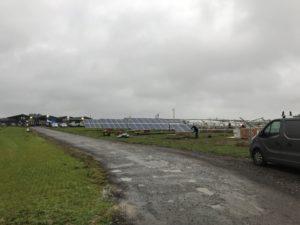Sun set to shine on UK solar costs

Day 3 of our own solar installation at NBJ near Husbands Bosworth
The cost of energy produced by large-scale solar plants in the UK is set to fall to £40 per megawatt-hour by 2030, according to the latest findings by the Solar Trade Association (STA).
The updated analysis for 2019 shows that solar has gone beyond the STA’s earlier expectations with levelised cost of energy costs of around £50-60/MWh in 2019, a figure which is also below the 2016 estimates by the UK Department of Business, Energy and Industrial Strategy (BEIS).
Though costs vary significantly on a site by site basis, STA’s findings confirm that under a long-term power purchase contract, solar could soon be the cheapest electricity generation technology in the UK.
The STA’s last assessment of solar’s LCoE, published in November 2014, had anticipated costs of around £80/MWh in 2019. STA policy analyst Nicholas Gall, who undertook the study working with STA members over the past six months, said: “This is yet another example of the fast-moving solar power market outpacing official costs analyses. “Our aim here is to provide an accurate assessment of where large-scale solar costs stand as we enter 2019, when we hope to see some revival of the UK large-scale solar market.”
STA’s analysis presented today shows solar can now be deployed at around £50-60/MWh, making it highly competitive with combined cycle gas turbine plants and onshore wind. Solar is also attractive for commercial and industrial consumers under long-term power purchase agreements.
The STA urges all organisations conducting low-carbon or energy cost analyses to make use of this up-to-date industry data, which comes directly from its members’ own experience of the UK market. “We also urge decision-makers to understand how effective policy frameworks enable the lowest possible costs for solar, which will greatly benefit consumers,” said Gall. A significant solar pipeline is expected to restart in the UK in 2019, assisted in the short term by developer needs to build out previously stalled projects, and by a global module surplus.
In the medium to longer term, the market outlook is supported by improved manufacturing efficiencies, higher gas price projections, and the UK’s growing need for clean generation capacity. However, policy uncertainties, such as Ofgem’s latest proposed changes to network charging, the future of carbon pricing given uncertainties over post-Brexit arrangements with the EU Emissions Trading System, and ongoing grid constraint challenges, also present challenges for the industry.
The analysis also underscores the high potential for UK content in large-scale solar and its contribution to gross domestic product, with imported modules likely to form just 10% of total lifetime costs by 2030.
Accompanying the cost figures released today, the STA sets out three targeted policy measures to facilitate growth of the large-scale solar market. The first is the introduction of a technology-neutral floor-price Contract for Difference auction. The second is enacting network access and charging reforms to enable storage plus solar to realise its full potential. The third is providing a Climate Change Levy exemption for newly built zero-carbon generation procured through corporate renewable PPAs.
STA chief executive Chris Hewett said: “We have a clear message for Government and corporate energy buyers today: UK solar electricity is now cost competitive with fossil fuels. “By establishing the right policy framework for solar and storage, including expediting a smart, flexible energy system, government can enable this technology to realise its full potential in delivering an affordable, low-carbon future energy system.”